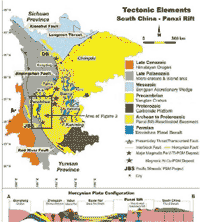Jinshan Gold Mines Releases Updated Resource Estimate For Jbs Platinum/Palladium/Nickel Project, China
May 13, 2004
BEIJING, CHINA - Jinshan Gold Mines announced today that an updated independent resource estimate has been prepared for the company's Jinbaoshan (JBS) Platinum-Palladium-Nickel-Copper (Pt-Pd-Ni-Cu) deposit in southwestern Yunnan Province, China. The new estimate was prepared in conformance with the requirements set out in National Instrument 43-101 by McDonald Speijers of Perth, Western Australia.
This resource estimate considers higher cut-off grades than earlier Chinese bulk tonnage resource estimates, to better reflect the economic tonnages based on estimated underground mining costs in China. The revised block model (10 x 12.5 X 2 metre blocks) for the North JBS deposit focused on a higher grade core. At these cut-offs, the resource model has sufficient lateral continuity for conventional underground mining. The McDonald Speijers report is available on SEDAR at www.sedar.com.
The resource is still open to the north. Jinshan is in discussions with its Chinese partners to expand the resource and extend the existing adit into the northern extension.
"China is now the world's number one consumer of platinum. There are excellent fundamentals for continued strong demand for the metal in China and any future production from the JBS project would be strategic to the Chinese market," said Jinshan's President Jay Chmelauskas. "Due to the expected strong price for platinum and palladium in the coming years, we intend to build on this resource base towards a production decision".
JBS Pt-Pd-Ni-Cu Resources April 2004*

*Resource classifications conform to CIM Standards on Mineral Resources and Reserves referred to in National Instrument 43-101. The block model has used geological constraints defined by Jinshan geologists that will allow a realistic economic evaluation. Mineral resources that are not reserves do not have demonstrated economic viability. An indicated mineral resource is that part of a mineral resource for which quantity and grade can be estimated with a level of confidence sufficient to allow the application of technical and economic parameters to support mine planning and evaluation of the economic viability of the deposit. An inferred mineral resource is that part of a mineral resource for which quantity and grade can be estimated on the basis of geological evidence and limited sampling and reasonably assumed, but not verified. The contained nickel, copper, platinum and palladium represent estimated contained metal in theadjustment factor to account for differences in relative metallurgical recoveries will depend upon the completion of definitive metallurgical testing.
Metallurgical test work conducted by specialists in South Africa confirmed earlier Chinese testing with recoveries ranging between 70% and 80%.
John McDonald, Principal of McDonald Speijers, is the qualified person responsible for overseeing the technical information regarding the new resource estimate at the JBS Project.
In the region adjacent to the project, Jinshan has exploration permits covering over 1,300 km2 of exploration ground. The exploration goal in the JBS Region is the discovery of massive to heavily disseminated, PGE-Ni-Cu sulphide deposits in mafic-ultramafic intrusions. This target type is commonly known as the "Noril'sk type", in reference to the large PGE-Ni-Cu sulphide deposits in the Noril'sk Region of northern Russia. The Noril'sk Region deposits are thought to contain approximately 900 million tonnes @ 2.7% Ni, 1.3 to 2.5 % Cu, with 7 g/t tonne PGE. They are hosted in a number of intrusions that were part of a network of feeders to the Siberian Traps (flood basalts). Outside of the Noril'sk district, the SW China flood basalt province has the next best PGE-Ni-Cu endowment with numerous occurrences and deposits.
The JBS regional geology and the Noril'sk-type deposits share the following characteristics:
- Rapid ascent of a very hot basaltic melt.
- Interaction with and emplacement of the magma, into sulphur-bearing rocks.
- Intense magma flow through feeder intrusions to flood basalts.
- Magmatic Ni-Cu sulfides collect in troughs at the base of intrusions.

Regional geological setting of the JBS Regional PGE Project, Yunnan, China
(Click on thumbnail to view full sized image)

Cross-section of JBS ultramafic intrusion. PGE-Ni-Cu zones occur in thickened central trough of intrusion.
(Click on thumbnail to view full sized image)
Jinshan shares are listed on the TSX Venture Exchange under the symbol JIN.
Investors: Bill Trenaman/ Media: Bob Williamson: +1.604.688.5755
Email: [email protected] Website: www.jinshanmines.com
The TSX Venture Exchange has not reviewed and does not accept responsibility for the adequacy or accuracy or this release.
Forward-Looking Statements: Statements in this release that are forward-looking Statements are subject to various risks and uncertainties concerning the specific factors disclosed under the heading "Risk Factors" and elsewhere in the company's periodic filings with Canadian securities regulators. Such information contained herein represents management's best judgment as of the date hereof based on information currently available. The company does not assume the obligation to update any forward-looking statement.




